As I was walking on Dartmoor yesterday (two months ago in real time!), I began to think about my bag, which meant I began to think about what I carry on a day hike on Dartmoor and I thought that might be quite a good subject for a blog post. Note it’s “what I carry” and not “what you should carry”. In theory, there shouldn’t be too much difference between the two but there’s enough difference that I kind of want to distance myself from telling you what you should carry.
The bag: Mountainlife Walkabout 20
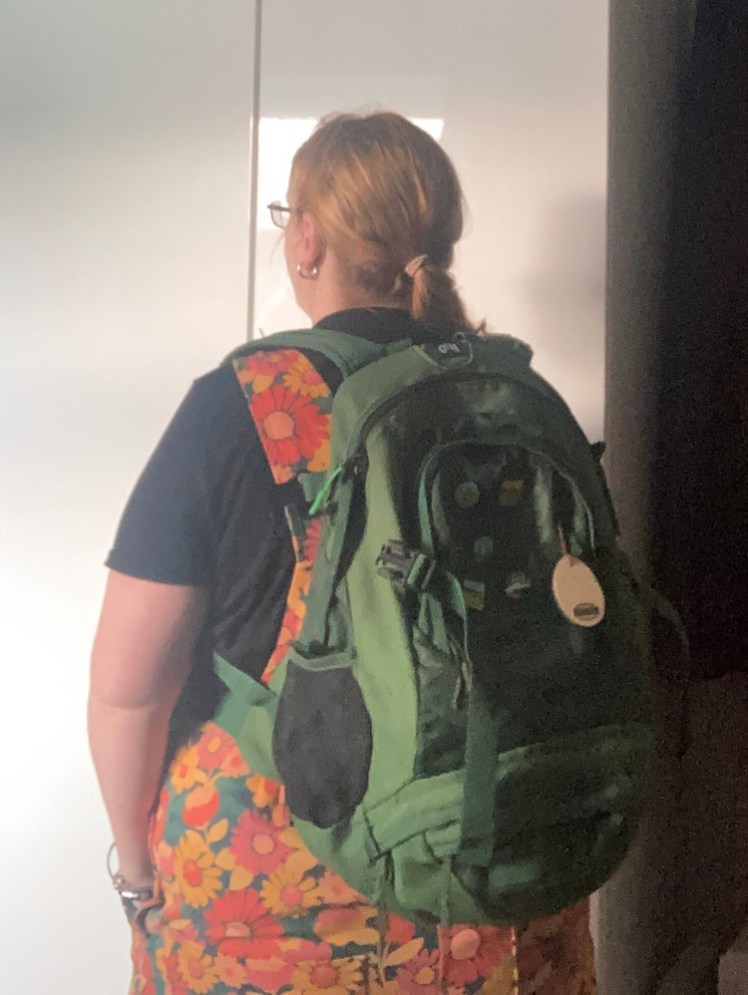
This is the bag I’ve used since… well, I can’t remember how long I’ve had the bag. I’ve been under the impression it’s a 28l bag but looking at it to get its name, I’ve discovered it’s actually a 20l, which would explain why it’s not quite big enough. I like that it’s got lots of pockets so I can put things in convenient places but by the time I’ve got basics like waterproofs, a jumper and my lunch in there, there isn’t much space for more. Admittedly, the bigger the bag, the more I’m going to carry. I have a 45l Vango bag which I used as the day bag for the Laugavegur trail but it’s ludicrously big for 10-14km on Dartmoor. 30-35l would probably be a good size but bags are expensive. I tried out a 35l bag from Lidl and there’s nothing wrong with it but I just still like my own more.
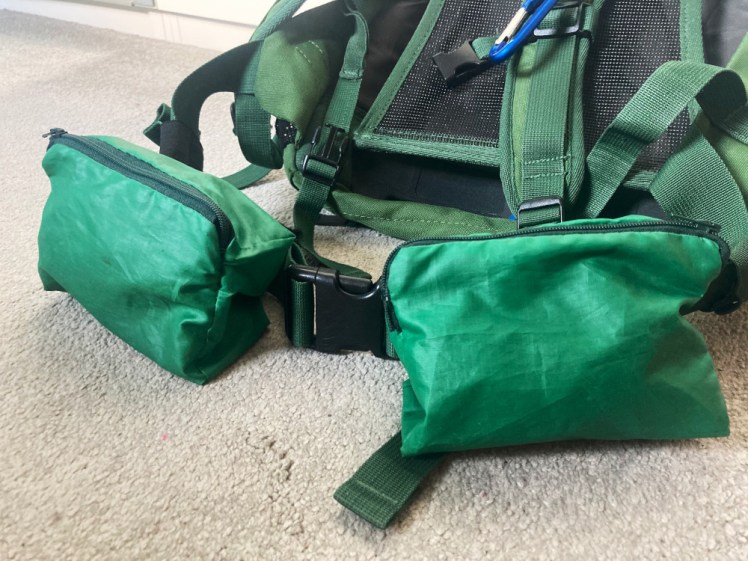
Other criticisms: all the other ladies from the Region group seem to have pockets on their hip belts. Mine doesn’t have them but again, it’s not a big enough issue for me to replace it – or rather, I haven’t found the right bag for the right price yet. So I made pockets. If you read that post, you’ll see how I did it but you’ll also see that they fell apart. I didn’t leave a big enough seam allowance and cordura apparently frays very easily. I said at the end that I was ordering some ripstop nylon, and remaking them in that has worked very well. They’re pristine. They’re a bit more wobbly; I didn’t use anything to reinforce them so they have no structure and don’t hold their shape but they’re really convenient and they haven’t come apart.
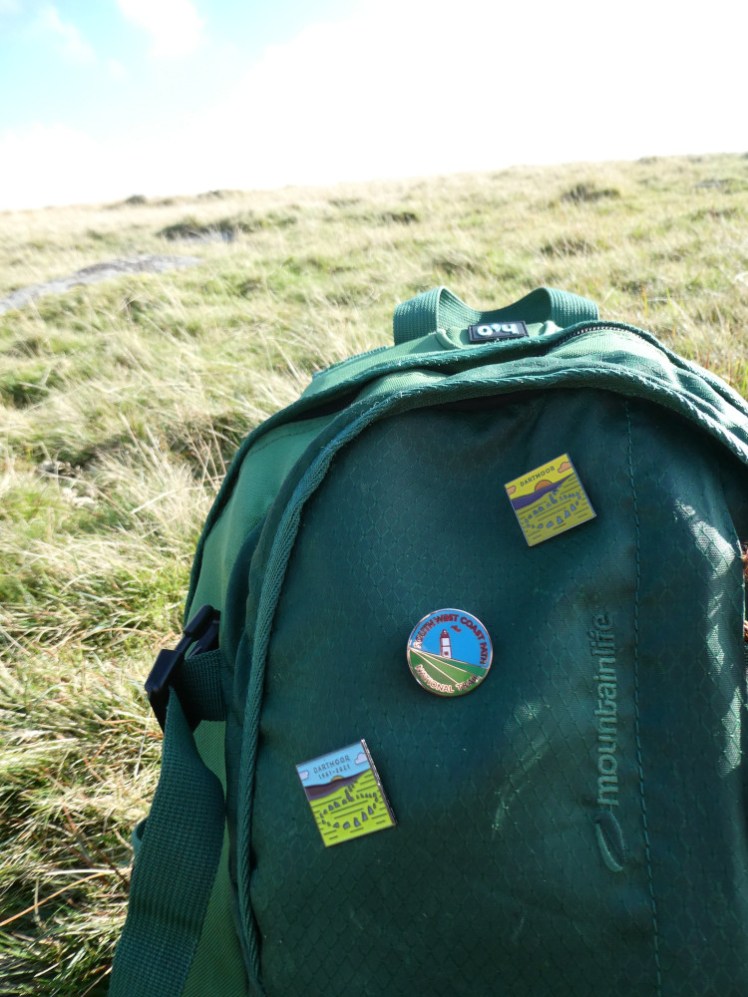
The bag has a small pocket in the bottom, it has a zip along the bottom and a zipped inner “floor” to turn the main compartment into two compartments. I have two pockets on the front – a main small front one and then a zipped compartment in the flap for the main small front one. Finally, I have mesh pockets on the side and compression straps, which are handy for water bottles and poles and on the back, there’s a hidden pocket containing a waterproof cover.
What’s in the bag?
First and most important, if you’re on Dartmoor, is full waterproofs – trousers as well as jacket. I thought yesterday was such a lovely sunny day that I wouldn’t bother and that’s a mistake. By the time I got over Rippon Tor, it was clouding over and I spent nearly six kilometres worrying that I’d get caught in the rain like an idiot.

My waterproof jacket is a Regatta Women’s Calderdale III in Blue Aster Dark Denim . It’s the same as my previous one, just a model or two later, and I only replaced it because I can’t get the old one done up around the middle, not because there was anything wrong with it. My new one was the previous season’s colour – my favourite tip for getting outdoors gear cheaper. I don’t care what colour is popular this season. I don’t think anyone does. I know you can spend as much money as you have on good waterproofs but I honestly don’t have any complaints about this jacket.
My waterproof trousers are just whatever trousers from Decathlon. I do have a complaint but it’s not their fault. They’re too long. They’re about six inches too long. That’s entirely my fault – in order to get them on, I had to go up enough sizes that the legs ended up too long. But again, they seem to do the job pretty well and when I’m wearing boots, the length doesn’t matter so much. I guess it bunches up around my ankles a bit, whereas when I’m wearing sandals, it all gathers on and around my feet, which is annoying. There’s a built-in pouch at the front which I can fold them away into but I prefer to put jacket and trousers into their own hand-made bright orange drawstring bags – it keeps them nice and small and it also makes them really easy to find in a bag.
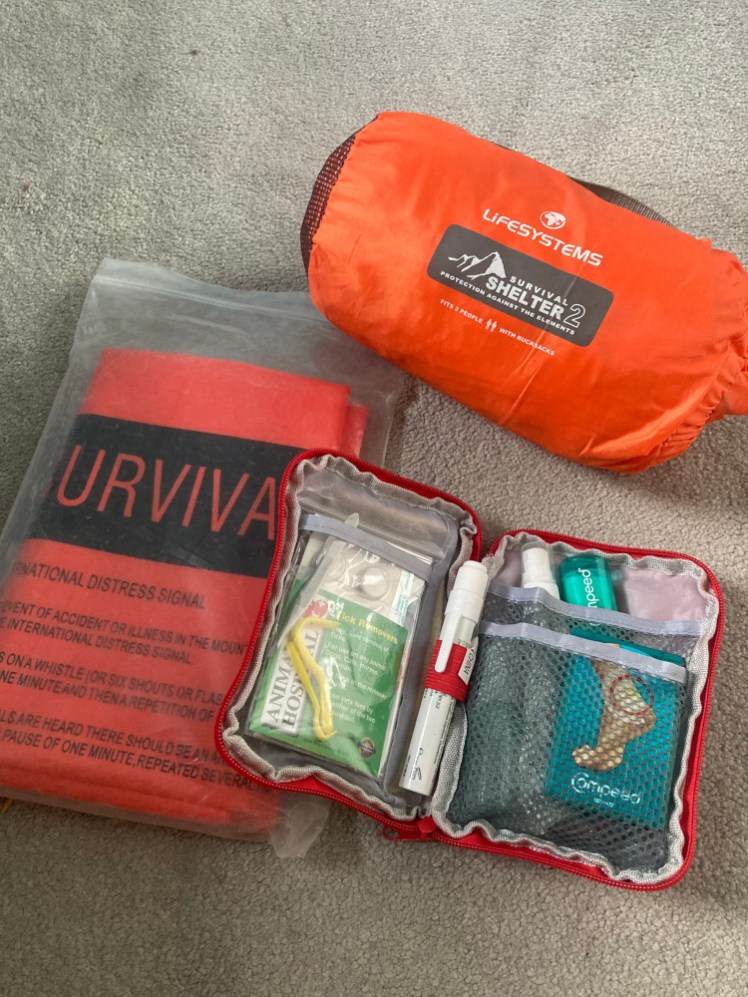
Next: first aid kit. Not much to say about this because I’ve already done the post on the subject but let’s say it anyway. The main things I use it for are sore feet, so it’s full of Compeed blister plasters. I also have a tiny bottle of The Body Shop’s cooling foot spray and a stick of Compeed foot lube for hotspots or just tired feet. Then there’s a tiny bottle of spray disinfectant for when I want to clean something without rubbing it, ordinary plasters, a roll of electrical tape (really useful for everything from small plasters to holding bandages together), a length of tubular bandage in case my knee or ankle goes, a tube of After Bite, a silver space blanket, a pair of tweezers for splinters and a two-pack of tick removers. Never had to use them but especially on Dartmoor, they’re worth carrying. Mine are designed for animals, which mostly means they’re a handy hook-shape and they’re cheaper than the human variety, which tend to be straighter (that’s a link to Amazon but it’s not an affiliate link).
Relatedly, I also carry a certain amount of emergency equipment. If I’m on my own, I’ll usually take my orange survival bag. If I’m with a group, I’ll see if I can squeeze in my group shelter – it takes up a lot of room in my 20l bag so it’s not guaranteed. It’s a two-person group shelter but it’s better than nothing. I sometimes have an orange plastic whistle around – it’s my old caving whistle, repurposed for above ground. I think it’s usually in my pockets although right now it’s in my buoyancy aid. And sometimes I’ll have a headtorch, just in case. To be honest, if I end up benighted, something has gone really wrong but it’s also handy if you come across a cave you want to be nosey about. It’s also good for signalling, even in daylight.

Spare clothes: I don’t carry much. I’m rarely, if ever, going to be out longer than six hours and I don’t generally feel the need for an entire second wardrobe. I’ll almost always take a spare fleece. My favourite one is a green Didriksons 1913 microfleece. It zips up, so it lets me decide exactly how warm I want to be, it has pockets, it has a hood and it has tight enough elastic at hem and wrists that I can be sure no cold is escaping. I often carry a blue tunic-style fleece and after this weekend, I wonder why, when the green one has so many more features and is smaller and lighter.

I occasionally take a softshell. Mine is from Mountain Warehouse and I bought it in 2016 with the gift card I got when I left my job the first time. I don’t think the exact model exists. It’s very plain and basic with no frills, fusses or decorations, in exactly the same bright blue as the fleece I sometimes take. It has two pockets and a hood, it’s warm and showerproof – basically, I take it instead of the fleece if I’m expecting it to be damp. Full-on rain, out come the waterproofs but the softshell can cope with a bit of light rain as well as being just as warm as a fleece. It’s a little bit tighter but again, that’s on me.
If there’s a hint of rain in the air, I’ll put the warm clothes in a drybag. No use having a spare jumper if it’s every bit as wet as the one you’re already wearing.
Lunch: I have a little zipped coolbag – not that it’s at all cool if the icepacks aren’t in it and I don’t carry icepacks. That’s just unnecessary weight. I generally make a cheese sandwich which I put in a silicon sandwich bag – all the good of a disposable sandwich bag with all the good of being endlessly reusable! – and then I pile in whatever snacks are handy, usually involving chocolate. I also try to keep snacks close at hand, like in those hip belt pockets I made because one thing I know I don’t do enough of while I’m walking is eating. With the Region group, we stop for tea an hour or so in and we make a definite stop for lunch. Yesterday, I stopped for three small pieces of chocolate and two drinks and that’s it. That’s a bad habit. Stop for lunch.
Drink: I have a 750ml bottle which I fill up with squash. Sorry. I know it’s supposed to be just water but I like a bit of flavour and a bit of sugar. I have a friend who loads up a Camelbak with Coke for days out on the hill. I find 750ml is just enough for a day on Dartmoor, if I ration it a bit as I approach the car. Sometimes I also carry a 500ml folding bottle bag which I can squish into but they tend to leak or go mouldy in a way a good old-fashioned plastic bottle doesn’t. I’ve tried reservoirs so I can drink without having to stop. They just don’t work for me personally. I also sometimes take a flask – well, Lifeventure Thermal Mug – of hot chocolate. If I’m on my own, I 100% will not drink it. Hot drinks just aren’t a habit of mine. If I’m with the Region group, they always stop for a tea break in the morning so I’ll sometimes drink it then. It’s a good thing to take on a cold day but for me personally, I know it’s unlikely I’ll really want it.
What’s attached to me?
Anything I want easy and regular access to is either attached to me or to the straps of the bag.

Map and route card. These both go in a waterproof map case which I hang around my neck. The one I had for years has a crack in it, which means it’s no longer waterproof. I bought a new one but the string is really short – too short for me to hold it up to look at the map without it being too close to my face to focus on it. I have an OS map – OL28 – and I fold it so two “sections” are visible. If I’m walking beyond those two sections, I try to fold it so that I only have to turn it over to get at the rest of the route. Some people prefer the laminated version of the map without a case but I like to be able to carry my map hands-free and anyway, the laminated versions don’t like being folded so much.
I sometimes take a route card. If I’m walking with Region, there’s usually only one route card in the group and it’s usually not me carrying it. If I’m on my own, I’m more prone to writing out a route card. It’s not an essential but it contains a lot of useful information.
You can’t really use a map without a compass. I’ve not yet decided how best to carry the compass. It used to be attached to the map case but its string was so long that it hung around my knees and that’s obviously not ideal. I’ve attached it to the D-rings on my back straps but it hangs down. If I tie a knot in it to shorten it, it comes undone or it gets tangled in my map case. It’s currently on a carabiner, hanging from a length of paracord tied into an emergency bracelet and that’s ok but I have to unclip it when I want to hold it against the map. How does anyone else handle the compass? My compass is a Silva Field, I think, although it’s got a blue bevel, not a black one, and I’ve attached a length of cord to it with five toggles on it, to act as pacing beads – count off 100m, slide the bead up. Once you reach 500m, pacing is going to lose a certain amount of accuracy. The Army has a different opinion on this – their pacing beads seem to cover huge distances.
Sometimes I’ll take my hiking poles. They’re useful for crossing streams or finding the ground in really long grass over uneven muddy land. But they’re also a bit of a pain to carry; it means I have my hands full at all time and although I can slip the loops over my wrists, they’re long enough to still be in the way. Yes, I can shrink them but I don’t want to do that just because I’ve stopped to check the map. Mine are the absolute basic Decathlon own-brand Forclaz MT100 and they collapse using a push pin system, which means it’s really easy to get them both the same length. They also shrink down smaller than the ones my mum has with the more traditional twisting mechanism, which means they fit in a suitcase so she can take them on holiday. One thing I particularly enjoy about them is that the wind blows across the empty holes and they whistle, exactly like a flute. It’s not so loud it’s obnoxious so I quite enjoy my hill music. For what it’s worth, I didn’t take them this weekend, mostly because it didn’t cross my mind until I reached the Devon border.
GPS tracker. I have a Garmin eTrex 10 which I took with me to track my route this time. I still haven’t figured out exactly where to put it so I kept it around my neck – but that was partly because I hadn’t planned a route and I needed to check whether I was at 10km yet or not. I usually take something called the i-gotU from long-defunct Maplin, which is a tiny little box with two LEDs inside it that you can barely see in daylight. It tracks but you can’t get anything out of it until it’s connected to your computer with the proprietary cable, so it’s no use in finding your way but it’s great for seeing where you’ve been and what you’ve done – as long as it finds the satellite signal before you set off, and it can take ten minutes to notice that. Rule of thumb: switch it on as soon as you arrive. Don’t wait until you’ve got your boots and coat on and you’re finding a safe pocket for the car keys. Downside: it takes about 16 hours to charge and I use it so rarely that it needs a full charge every time. And it’s not waterproof. It has a silicone cover but the port is left exposed so it can be easily charged, and that’s the particular bit you don’t want to get water in. Because of the way it’s designed, the corner you can attach a loop to is on the bottom so it’s hanging upside down with its open port exposed to the sky. I clip it onto one of my bag’s D-rings and then I just have to check I haven’t accidentally switched it on or off when I take the bag off.
What do I wear?
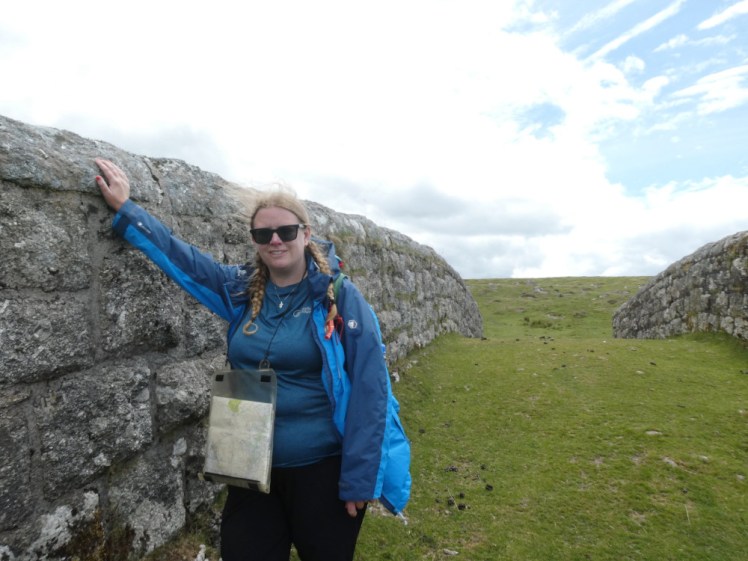
I’m old-school. I look askance at people hiking in leggings, sports bras and trainers. It may be ok in California but Dartmoor is chilly, damp, full of gorse and rife with ticks. This is what I wear:
Base layer. Sometimes this is an ordinary t-shirt. In 2018, for the Laugavegur Trail, I bought a couple of running t-shirts which wick moisture away and these are now my Dartmoor tops. I have a petrol-blue one with long sleeves and a red one with short sleeves – if you look at pretty much every photo here that’s not in Iceland, I’m wearing it under whatever fleece or jacket I’ve picked that day. I tend towards the long-sleeved one – I only really want the short-sleeved one when it’s hot and then I know I’m going to miss patches with my suncream and end up burned, so the long-sleeves just works better all round.
Mid layer: this is either the blue or green fleece mentioned above or the softshell, also mentioned above, depending on conditions and weather forecast.
Waterproof shell: well, I’ve already mentioned those too.
Trousers: I like lightweight quick-drying hiking trousers. I used to get whatever fitted from Go Outdoors but the ones I’ve been wearing since 2018 are all from Decathlon. I have some warm lined ones for winter but those get used more for travel than hiking. The ones I’m wearing right now are own-brand Quechua, with pink zips for ventilation in lower legs and around my thighs so I can turn them into shorts. They also have a diamond pattern for extra grip on the knees and tiny pinholes for ventilation behind my knees. I can’t find them on the Decathlon website so I don’t know what they’re called but honestly, anything lightweight and quick-drying will do for me.
Now, I’m a bad hiker in that I prefer ordinary thin black socks from Tesco/Primark/wherever over proper hiking socks. I find hiking socks are just too thick and my feet end up squished. Maybe I need to wear the socks when I buy new boots and go up a couple of sizes to accommodate them. As for boots, I did a post on my waterproof mountain boots, which are Mammut Nova Women’s GTX. They sometimes cause blisters on the outside of my right heel but never on the soles. They’re quite narrow-fitting and they’re quite solid. If it’s not going to be wet, I might wear my non-waterproof boots, which are a bit wider and therefore a bit more comfortable. They’re Karrimor Bodmin Mid IV Ladies, in grey and blue. My sister has exactly the same ones and on occasion, they end up in the same house. Fortunately, her feet are at least two sizes bigger than mine and her boots are usually less muddy. If I’m going to Dartmoor, I’ve usually got both pairs in the car and then if one pair gets soaked on Saturday, I’ve got dry boots for Sunday but I’ll pick which pair gets used first depending, really, on how wet I’m expecting my feet to get.
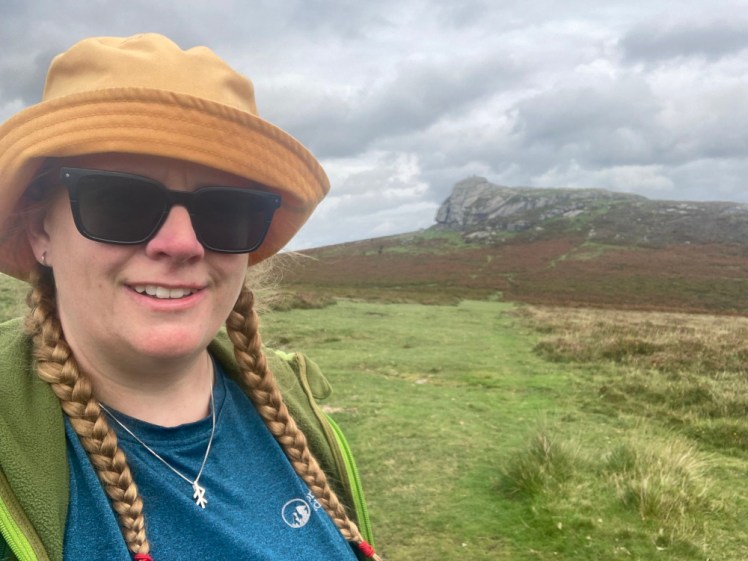
Accessories: I go nowhere without my polarised prescription sunglasses. No idea what brand they are; any sunglasses that are both polarised and prescription and don’t require me to take out a mortgage are the ones I buy when I find myself in need of a new pair. I usually take a hat, usually a blue bucket hat if it’s hot, or one of my Tom Hats if it’s cold. Ever since I filled my non-waterproof steel Swatch watch with water falling in a bog in Wales, I wear my indestructible Baby G watch out hiking – twelve-year-old me would be both delighted I finally own this thing and astonished I treat it as a practical item rather than a fashion one.
And that’s about it, I think. Yes, it’s a bit much for a 20l bag. On the other hand, I could load up a suitcase with the stuff I could take out for the day so it’s best to keep it small. Is there anything I’m missing? Anything you think invaluable?